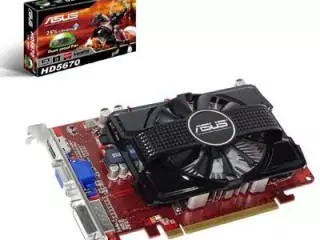GeForce GTX 850A vs Radeon HD 5670
If you are going to buy a new graphics card and are choosing between GeForce GTX 850A and Radeon HD 5670, there are a couple of things to consider. Cards with more VRAM in general perform better and allow you to play on higher graphics settings. Size also makes a difference. A model with a large heatsink can occupy up to three expansion slots on a motherboard. Be sure you have enough room in your PC case. When comparing GPUs with different architectures, more processing cores and even higher TFLOPS will not always translate to better performance. To help you decide which GPU you need, we have measured frame rates in a number of popular games. For more on how the GeForce GTX 850A stacks up against Radeon HD 5670, check out specs charts below.
GeForce GTX 850A
Main Specs
GeForce GTX 850A
Radeon HD 5670
Power consumption (TDP)
45 Watt
64 Watt
Interface
PCIe 3.0 x16
PCIe 2.0 x16
Supplementary power connectors
None
Memory type
DDR3
GDDR5
Maximum RAM amount
2 GB
1 GB
Display Connectors
No outputs
1x DVI, 1x HDMI, 1x VGA
Check Price
Radeon HD 5670 has 42% more power consumption, than GeForce GTX 850A.
GeForce GTX 850A is connected by PCIe 3.0 x16, and Radeon HD 5670 uses PCIe 2.0 x16 interface.
GeForce GTX 850A has 1 GB more memory, than Radeon HD 5670.
Both cards are used in Desktops.
GeForce GTX 850A is build with Maxwell architecture, and Radeon HD 5670 - with Terascale 2.
Core clock speed of GeForce GTX 850A is 127 MHz higher, than Radeon HD 5670.
GeForce GTX 850A is manufactured by 28 nm process technology, and Radeon HD 5670 - by 40 nm process technology.
Memory clock speed of GeForce GTX 850A is 800 MHz higher, than Radeon HD 5670.
Game benchmarks
Assassin's Creed Odyssey
Battlefield 5
Call of Duty: Warzone
Counter-Strike: Global Offensive
Cyberpunk 2077
Dota 2
Far Cry 5
Fortnite
Forza Horizon 4
Grand Theft Auto V
Metro Exodus
Minecraft
PLAYERUNKNOWN'S BATTLEGROUNDS
Red Dead Redemption 2
The Witcher 3: Wild Hunt
World of Tanks
high / 1080p
1−2
0−1
ultra / 1080p
0−1
−
QHD / 1440p
0−1
0−1
low / 720p
12−14
1−2
medium / 1080p
3−4
0−1
The average gaming FPS of GeForce GTX 850A in Assassin's Creed Odyssey is 1200% more, than Radeon HD 5670.
ultra / 1080p
4−5
−
QHD / 1440p
0−1
0−1
low / 720p
16−18
0−1
medium / 1080p
5−6
−
low / 768p
45−50
50−55
high / 1080p
40−45
45−50
QHD / 1440p
0−1
0−1
The average gaming FPS of Radeon HD 5670 in Call of Duty: Warzone is 11% more, than GeForce GTX 850A.
low / 768p
120−130
60−65
medium / 768p
90−95
27−30
ultra / 1080p
40−45
7−8
QHD / 1440p
24−27
−
4K / 2160p
18−20
−
high / 768p
65−70
16−18
The average gaming FPS of GeForce GTX 850A in Counter-Strike: Global Offensive is 189% more, than Radeon HD 5670.
low / 768p
85−90
70−75
ultra / 1080p
16−18
0−1
medium / 1080p
40−45
45−50
The average gaming FPS of GeForce GTX 850A in Cyberpunk 2077 is 8% more, than Radeon HD 5670.
low / 768p
75−80
45−50
medium / 768p
50−55
10−11
ultra / 1080p
24−27
0−1
The average gaming FPS of GeForce GTX 850A in Dota 2 is 124% more, than Radeon HD 5670.
high / 1080p
2−3
−
ultra / 1080p
2−3
−
4K / 2160p
0−1
−
low / 720p
12−14
0−1
medium / 1080p
3−4
−
high / 1080p
10−11
−
ultra / 1080p
5−6
−
QHD / 1440p
2−3
−
low / 720p
50−55
21−24
medium / 1080p
10−12
0−1
The average gaming FPS of GeForce GTX 850A in Fortnite is 136% more, than Radeon HD 5670.
high / 1080p
4−5
0−1
QHD / 1440p
0−1
0−1
low / 720p
16−18
0−1
medium / 1080p
7−8
0−1
low / 768p
45−50
18−20
high / 1080p
5−6
0−1
ultra / 1080p
2−3
−
QHD / 1440p
0−1
0−1
medium / 720p
35−40
12−14
The average gaming FPS of GeForce GTX 850A in Grand Theft Auto V is 162% more, than Radeon HD 5670.
high / 1080p
1−2
−
ultra / 1080p
0−1
−
4K / 2160p
0−1
−
low / 720p
5−6
0−1
medium / 1080p
3−4
−
low / 768p
90−95
75−80
high / 1080p
85−90
27−30
ultra / 1080p
70−75
−
medium / 1080p
90−95
−
The average gaming FPS of GeForce GTX 850A in Minecraft is 69% more, than Radeon HD 5670.
ultra / 1080p
12−14
−
low / 720p
27−30
8−9
medium / 1080p
14−16
−
The average gaming FPS of GeForce GTX 850A in PLAYERUNKNOWN'S BATTLEGROUNDS is 250% more, than Radeon HD 5670.
ultra / 1080p
4−5
−
QHD / 1440p
0−1
−
low / 720p
6−7
0−1
low / 768p
12−14
0−1
medium / 768p
9−10
−
high / 1080p
4−5
−
ultra / 1080p
3−4
−
4K / 2160p
0−1
−
low / 768p
75−80
45−50
medium / 768p
35−40
14−16
ultra / 1080p
16−18
0−1
high / 768p
30−35
12−14
The average gaming FPS of GeForce GTX 850A in World of Tanks is 96% more, than Radeon HD 5670.
Full Specs
GeForce GTX 850A
Radeon HD 5670
Architecture
Maxwell
Terascale 2
Code name
GM107
Redwood
Type
Desktop
Desktop
Release date
17 March 2014
14 January 2010
Pipelines
640
400
Core clock speed
902 MHz
775 MHz
Boost Clock
936 MHz
Transistor count
1,870 million
627 million
Manufacturing process technology
28 nm
40 nm
Texture fill rate
37.44
15.50
Floating-point performance
1,198 gflops
620.0 gflops
Length
168 mm
Memory bus width
128 Bit
128 Bit
Memory clock speed
1800 MHz
1000 MHz
Memory bandwidth
28.8 GB/s
64 GB/s
DirectX
12 (11_0)
11.2 (11_0)
Shader Model
5.1
5.0
OpenGL
4.6
4.4
OpenCL
1.2
1.2
Vulkan
1.1.126
N/A
CUDA
5.0
Check Price


